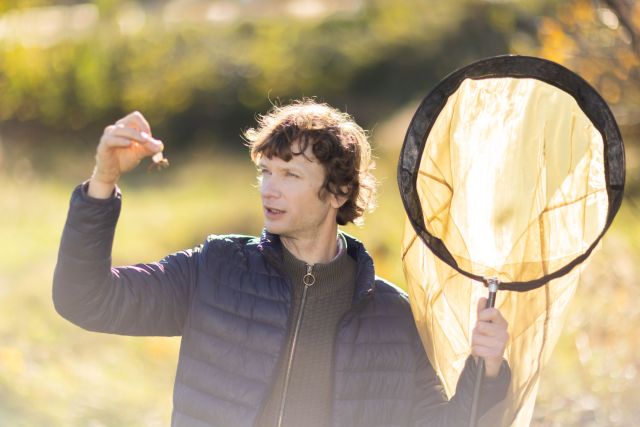Principal Investigator
:
Dr hab. Szymon Śniegula
The Institute of Nature Conservation, Polish Academy of Sciences
Panel: NZ8
Funding scheme
: GRIEG
announced on
17 June 2019
Cities worldwide are experiencing dynamic growth and development. Urbanization poses various challenges to wild organisms, contributing to the loss of biodiversity through the introduction of invasive species, and expanding cites are stealing natural landscapes from native animals. Small water bodies, such as rural and urban ponds, often serve as reservoirs of biodiversity in areas under human pressure. Unfortunately, their value is frequently underestimated. Moreover, research on changes in biodiversity often has a local focus or is concentrated on individual species, making it challenging to draw conclusions on a broader scale. In the ongoing climate and ecological crisis, understanding the mechanisms of biodiversity loss in ponds on a broader geographical and environmental scale is crucial for effective habitat management.
 Dr hab. Szymon Śniegula, photo by Michał Łepecki
The ECOPOND project collects information on biodiversity in ponds from five European regions, with the added aspect of also considering different levels of urbanization in the respective areas. When applying this sampling setup, we obtain a higher comprehensive picture of the condition and changes in biodiversity of these ponds, checking for any alarming trends. Using modern analytical techniques, we identify species diversity using environmental DNA and RNA (eDNA, eRNA) filtered from pond water. We have demonstrated that the eRNA method is more effective for algae, while eDNA recognizes a larger part of fungi. We have also found that geographic region and sampling period (spring or fall) influence the results. Furthermore, we have demonstrated that species diversity decreases with increasing geographical latitude, particularly when comparing eDNA samples collected in the first half of the growing season (spring). The results are highly significant for planning effective pond biomonitoring, tracking species biogeography, and assessing the condition of freshwater organisms.
Dr hab. Szymon Śniegula, photo by Michał Łepecki
The ECOPOND project collects information on biodiversity in ponds from five European regions, with the added aspect of also considering different levels of urbanization in the respective areas. When applying this sampling setup, we obtain a higher comprehensive picture of the condition and changes in biodiversity of these ponds, checking for any alarming trends. Using modern analytical techniques, we identify species diversity using environmental DNA and RNA (eDNA, eRNA) filtered from pond water. We have demonstrated that the eRNA method is more effective for algae, while eDNA recognizes a larger part of fungi. We have also found that geographic region and sampling period (spring or fall) influence the results. Furthermore, we have demonstrated that species diversity decreases with increasing geographical latitude, particularly when comparing eDNA samples collected in the first half of the growing season (spring). The results are highly significant for planning effective pond biomonitoring, tracking species biogeography, and assessing the condition of freshwater organisms.
Ecological harm caused by invasive species can be enormous, leading to the elimination of native species or affecting them in other ways. An example is the parasitic fungus Batrachochytrium dendrobatidis (Bd), originating from Africa, which can have a catastrophic impact on amphibians. Using eDNA in water samples and swabs taken from amphibian skin, we have shown that the pathogenic Bd is already present in northern areas of Europe, attacking protected herpetofauna species. As the fungi likely only have been present in the north for a short time, the amount of infection has yet to be observed in negative population trends, if the fungus poses negative effects in the north. Our research also investigates the skin microbiome of amphibians, which is crucial for their health. For this, we examine both the common toad and the smooth newt found in both urban and suburban ponds. These results underscore the importance of the applied methods as tools for early detection of invasive pathogens and their impact on the health of amphibians in Europe.
In further research on herpetofauna, we detected dangerous infections with the RaHV3 herpesvirus in Norway, which can manifest as severe skin disease. We were also the first to discover scientifically that the virus are infecting frogs already at the larval stage from wild tadpoles as the virus have yet to be grown in the laboratory. With the virus only discovered in 2021 there are no data on mortality in wild populations, but we have reasons to believe there are costs associated to being infected.
 Dr hab. Szymon Śniegula, photo by Michał Łepecki
Threats from transmittable diseases may be particularly significant for toads and newts, as we have not identified genetic diversity between urban and suburban populations, suggesting high migration between populations (gene flow). This may facilitate the spread of both native and foreign pathogens, resulting in potential decline in the condition and abundance of amphibians, not only locally but also on larger scales.
Dr hab. Szymon Śniegula, photo by Michał Łepecki
Threats from transmittable diseases may be particularly significant for toads and newts, as we have not identified genetic diversity between urban and suburban populations, suggesting high migration between populations (gene flow). This may facilitate the spread of both native and foreign pathogens, resulting in potential decline in the condition and abundance of amphibians, not only locally but also on larger scales.
Important threats also concern the blue-tailed damselfly, an insect that regulates, among other things, the number of biting mosquitoes. Research on the impact of the invasive spiny-cheek crayfish, combined with urban "heat waves", on damselfly larvae indicates a significant influence of these stressors. Specifically, urban and rural damselflies responded differently in growth rate and body size (traits associated with reproductive success) to predator smell and elevated temperature. We have further demonstrated that northern and southern damselflies differ considerably in gene expression for the examined traits. This signifies an impact of urbanization and geographical origin on the survival strategies of organisms.
In conclusion, our research reveals a series of challenges and pressure that urbanization exerts on biodiversity, both at the local and continental levels. The impact of invasive species, pathogens, and environmental changes on the health and abundance of aquatic organisms requires continuous monitoring and the development of effective protection strategies. Our results provide insight into the mechanisms occurring in nature, forming the foundation for further actions in conserving biological diversity in urban ecosystems.
Project title: The ecology of ponds in the context of human activity and geography - environmental DNA and beyond
Dr hab. Szymon Śniegula
The graduate of the West Pomeranian University of Technology in Szczecin and the University in Umeå, Sweden. Doctoral degree in biological sciences obtained at the Institute of Nature Conservation PAS; habilitation at the Institute of Systematics and Evolution of Animals PAS. Postdoctoral fellowships at Uppsala University in Sweden and KU Leuven in Belgium. Research interests: evolutionary ecology of life history and physiological traits, behaviour, and quantitative genetics of insects. Principal investigator and co-investigator of national and international projects, including NCN, Norway Grants. Member of scientific societies, including European Society for Evolutionary Biology, Worldwide Dragonfly Association, Polish Entomological Society. Author and co-author of over 40 scientific publications.


